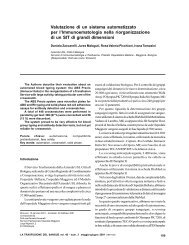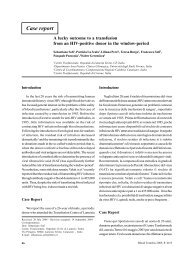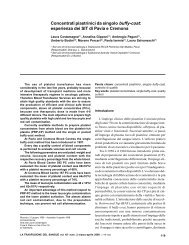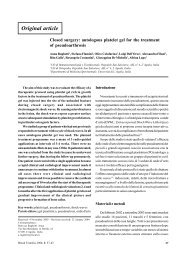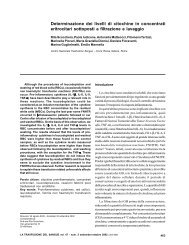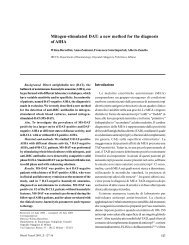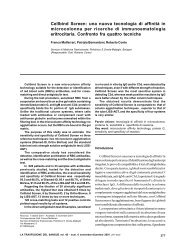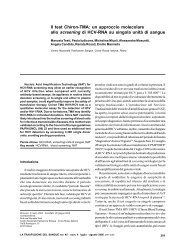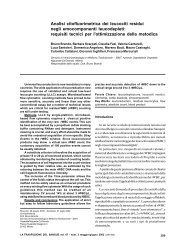Mathematics and transfusion medicine - Blood Transfusion
Mathematics and transfusion medicine - Blood Transfusion
Mathematics and transfusion medicine - Blood Transfusion
Create successful ePaper yourself
Turn your PDF publications into a flip-book with our unique Google optimized e-Paper software.
Flegel W AFigure 1 - Duplication of the RH gene <strong>and</strong> deletion of the RHD gene. The ancestral conditionis shown as the RH gene locus in the mouse. The single RH gene is adjacent to thethree genes SMP1, P29-associated protein (P) <strong>and</strong> NPD014 (N). Duplication createda second, reversed RH gene in humans, which is located between N <strong>and</strong> SMP1. At theinsertion points before <strong>and</strong> after the RHD gene is a DNA segment about 9,000nucleotides or base pairs (bp) long. The two DNA segments flank the RHD gene <strong>and</strong>are termed the upstream or downstream Rhesus box. In the RHD positive haplotype,the RHD gene could be lost again through recombination (figure 3). The scale givesthe approximate length of 50,000 nucleotides in the genomic DNA.absence of the RhD protein in the erythrocyte membrane(D positive resp. D negative).It is unusual for erythrocyte or other cell proteins to belacking entirely in many humans. This particular geneticfeature contributes to the strong antigenicity of the RhDprotein. During duplication of the ancestral RH gene, twoDNA segments were formed, known as the Rhesus box(Figure 1) 9 . The RHD deletion resulted from an unequalcrossover (figure 3), which occurs when two DNAsegments are highly homologous, such as those of theRhesus box. The RHD negative haplotype commonestamong Europeans is characterized by a hybrid Rhesus box.Subtle molecular differences between the various forms ofthe Rhesus box are used for genetic testing.The molecular basis of D antigen variantsAside from lack of the RhD protein, the D negativephenotype is caused mainly by a series of changes in theRhD protein, which in turn change the phenotype of the Dantigen.Depending on the phenotype <strong>and</strong> their molecularstructure, these RHD alleles are classified as either partialD, weak D or DEL.Partial DThe RhD protein traverses the erythrocyte membraneseveral times, leaving only part of the protein exposed atthe surface (Figure 2). If an amino acid is substituted in aportion of the RhD protein which is located at the outersurface of the erythrocyte membrane, single epitopes ofthe D antigen can be lost or new antigens can be formed.DNB is the commonest European partial D (Table I).D categories are a subgroup of partial D. The structureof the RH gene site facilitates gene conversions (figure4) 10 . In the RHD gene some homologous exons of the RHCEgene will be inserted, forming a hybrid Rhesus allele whichexpresses a corresponding hybrid protein. This is how theD categories III to VI arose. The changes usually affect along string of amino acids, which is always located on theerythrocyte surface.52<strong>Blood</strong> Transfus 2007; 5: 50-57050-57_flegel.p65 5205/07/2007, 10.34



